Choosing between Bybit and Binance can be challenging for both new and experienced traders. These two leading and best crypto exchanges offer distinct trading features and benefits.
Bybit stands out for its focus on derivatives trading and advanced copy trading tools, while Binance shines with its high trading volume. In this guide, we will explore the key differences between Bybit vs Binance, comparing fees, trading volumes, security features, and coin offerings.
Key Takeaways:
- Bybit is best for derivatives trading, offering advanced tools, whereas Binance is ideal for high-volume spot and futures trading with wider services.
- Bybit offers over 1,200 coins and a better copy trading portal, while Binance supports around 400 coins, focusing mostly on high-cap and popular assets.
- Binance has deeper liquidity and higher trading volume, making it suitable for large-scale trades.
- Both Binance and Bybit have the same spot trading fees, but Binance has lower futures taker fees compared to Bybit (0.05% vs 0.055%).
Bybit vs Binance: Quick Comparison Table
| Feature | Bybit | Binance |
| Founded | 2018 | 2017 |
| Best for | Derivatives trading | High-volume spot and futures trading |
| Futures Market | USDT, USDC, and inverse perpetuals | USDC, USDT, and Coin-M perpetual contacts |
| Supported Cryptocurrencies | 1200+ | 400+ |
| Leverage | Up to 100x (on derivatives) | Up to 125x (on derivatives) |
| Fees | 0.1% (spot trading), 0.02%/0.055% (futures) | 0.1% (spot trading), 0.02%/0.05% (futures) |
| P2P Trading | Yes | Yes (Extensive) |
| Fee Discounts | Based on trading volume | Discounts with BNB and VIP tiers |
| Withdrawal Limits | $100,000 USDT/daily | $8 million USDT per day |
| Regulatory Licenses | VARA in Dubai and Cyprus | Lithuania, Poland, Australia, France, and more |
| Security | High | Very High ($1 billion SAFU fund) |
What is Bybit?
Bybit is a cryptocurrency derivatives trading platform that began in 2018. It quickly became well-known for providing a wide range of trading services, including spot and leverage trading. The platform is used by millions (over 40 million) of traders worldwide and supports over 1200 different cryptocurrencies like bitcoin and ethereum. It allows you to buy, sell, and trade these assets easily.
Trading using leverage is Bybit’s main selling point. To trade cryptocurrencies, you can borrow money up to 100x your initial investment. Even though there are greater risks involved, advanced traders will find this particularly appealing. Bybit also provides a service called “Bybit Earn”, which allows you to earn interest from your cryptocurrency holdings without having to trade.
Bybit also provides advanced tools for security, including two-factor authentication and offline (cold) storage of digital currencies. These measures are aimed at protecting users’ funds. However, it is important to note that Bybit is restricted in some countries, including the U.S., due to regulatory issues.
Bybit Pros
- 100x leveraged trading on popular assets like btc and eth
- 1200+ supported coins and tokens
- Competitive trading fees with discounts for high-volume traders
- Web3 features include a wallet and in-built DeFi swap
- Options trading supported for experienced traders
Bybit Cons
- Not available for the U.S. citizens
- Limited fiat deposit and withdrawal methods
- Some newly listed assets have low liquidity
What is Binance?
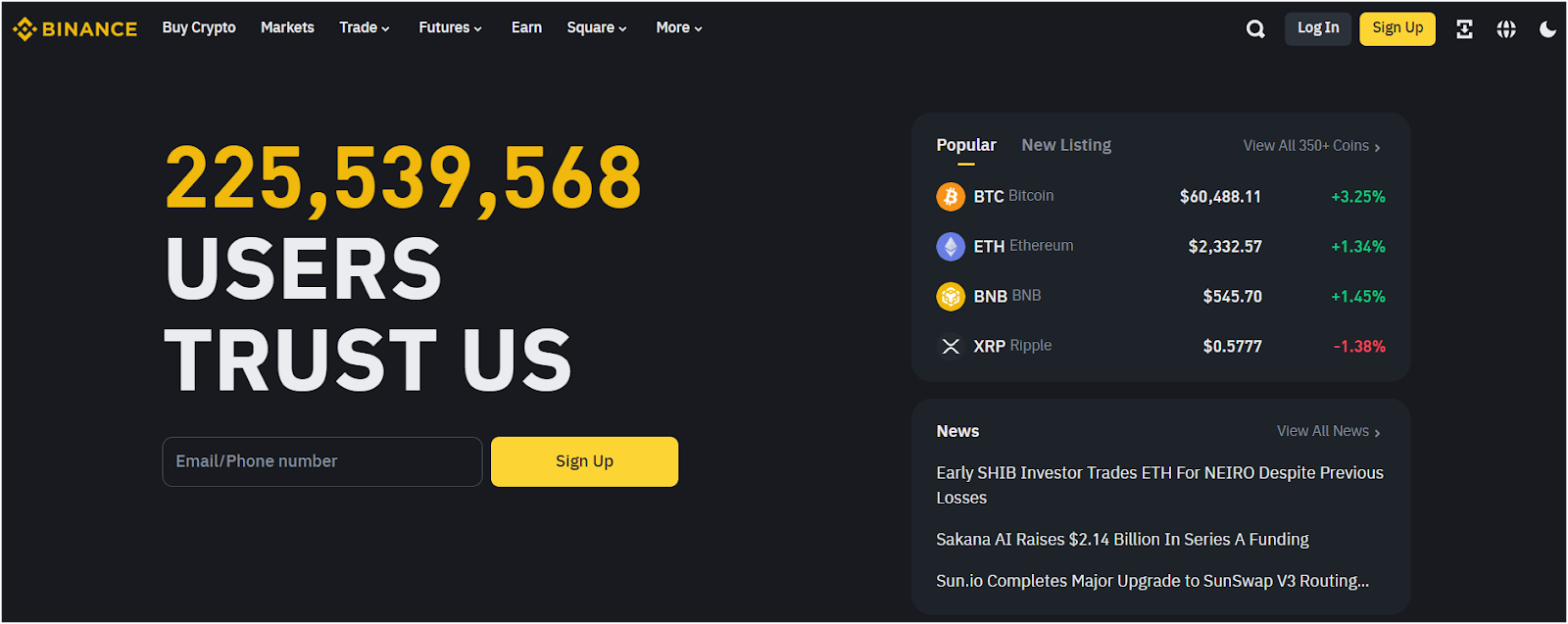
Binance is another crypto exchange best for providing high trading volume and liquidity. It has over 225 million registered users, showcasing its popularity among crypto users. It is also the best exchange for day trading due to its high liquidity. Numerous advanced trading features, including spot trading, futures trading, margin trading, launchpad, nft marketplace, and staking, contribute to its popularity. BNB Chain (formerly Binance smart chain) is the name of Binance’s proprietary blockchain.
It supports 40 different fiat currencies and offers services in 100+ countries. Binance also provides peer-to-peer trading options as more users choose to trade directly with each other. Binance’s passive income service, called Binance Earn, offers over 100% APY on some digital assets.
Despite facing legal and regulatory challenges in countries like the United States, Binance has continued to grow. The company invested heavily in improving its compliance measures to ensure it meets regulations worldwide. It is highly secure with a $1 billion SAFU insurance fund.
In addition to its main exchange functions, Binance has expanded into Web3 technologies. This includes launching tools like self-custodial wallets, which give users more control over their crypto assets.
Binance Pros
- Highest trading volume among the crypto exchanges
- Zero price slippage while trading
- 125x leverage for perpetual futures contracts
- Copy trading and automated bots for beginners
- Binance Pay for merchants and crypto payments
Binance Cons
- Separate Binance.us platform for U.S. users with fewer features
- Legal issues with multiple jurisdictions
- Only supports popular and high-cap altcoins
Bybit Fees vs Binance Fees
Bybit Trading Fees
The spot trading fee on Bybit for non-VIP users is set at 0.1% for both makers and takers. However, the platform provides lower fees for traders who qualify for higher VIP levels, determined by their asset holdings or trading volume over the past 30 days.
| Tier | Asset Value | 30-Day Spot Trading Volume | Maker Fees | Taker Fees |
| VIP 0 | – | – | 0.1% | 0.1% |
| VIP 1 | ≥ 100K | ≥ 1M | 0.0675% | 0.08% |
| VIP 2 | ≥ 250K | ≥ 2.5M | 0.065% | 0.0775% |
| VIP 3 | ≥ 200K | ≥ 5M | 0.0625% | 0.075% |
| VIP 4 | ≥ 1M | ≥ 10M | 0.05% | 0.06% |
Bybit’s fiat-to-crypto trading pairs (such as USDT/EUR) have their own fee structure. For regular users, the fees begin at 0.15% for maker orders and 0.2% for taker orders. Additionally, there are trading fee rebates tied to VIP levels for these pairs.
For example, a VIP 3 user with less than $100,000 in monthly spot trading volume would be charged 0.0750% for taker orders and 0.0625% for maker orders under VIP 3 rates.
You can view the complete list of Bybit’s fees on the official site.
Similar to spot trading, Bybit’s futures trading fees are also divided into maker and taker fees. The base rates for futures trading are 0.02% for makers and 0.055% for takers. However, the exact fee a user pays is influenced by their VIP status, with those in higher tiers paying lower fees.
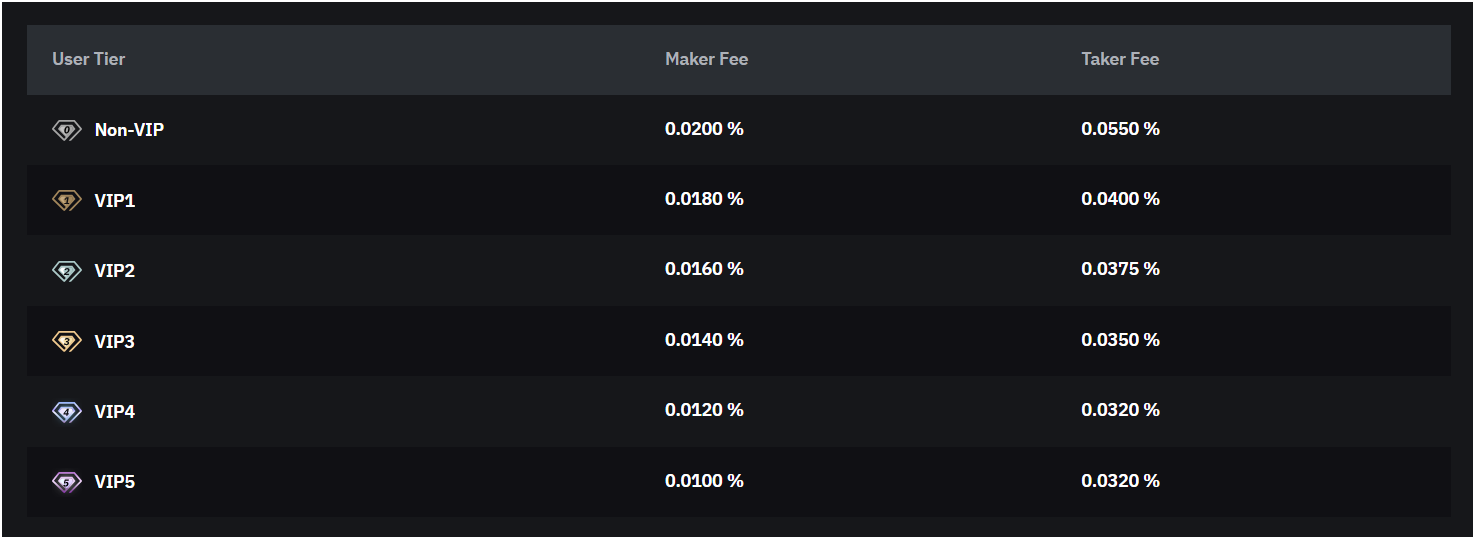
It’s worth noting that Bybit may also charge a settlement fee of 0.05% for all futures contracts when they expire.
In addition, Bybit charges fees for USDC options contracts. These fees are structured competitively, with the lowest rate starting at 0.02% for both maker and taker orders.
Binance Trading Fees
Similar to Bybit, Binance charges maker-taker fees. For spot trading, the standard fee is 0.10%. Users can reduce these fees by using BNB to pay, receiving a discount of around 25%. Higher VIP levels offer even lower fees.
| VIP Level | 30-Day Trade Volume (USD) | BNB Balance | Maker Fee | Taker Fee |
| 0 | – | < 25 BNB | 0.10% | 0.10% |
| 1 | ≥ 1M | ≥ 25 BNB | 0.09% | 0.10% |
| 2 | ≥ 5M | ≥ 100 BNB | 0.08% | 0.10% |
| 3 | ≥ 20M | ≥ 250 BNB | 0.042% | 0.06% |
| 4 | ≥ 100M | ≥ 500 BNB | 0.042% | 0.054% |
| 5 | ≥ 150M | ≥ 1000 BNB | 0.036% | 0.048% |
| 6 | ≥ 400M | ≥ 1700 BNB | 0.030% | 0.042% |
| 7 | ≥ 800M | ≥ 3000 BNB | 0.024% | 0.036% |
| 8 | ≥ 2000M | ≥ 4500 BNB | 0.018% | 0.03% |
| 9 | ≥ 4000M | ≥ 5500 BNB | 0.012% | 0.024% |
Futures trading fees on Binance are generally lower than spot trading fees and are also tiered by VIP level. The starting fee for futures trading is 0.02% for makers and 0.05% for takers. Like spot trading, those with higher VIP status benefit from reduced fees. Check the full Binance fee structure here.
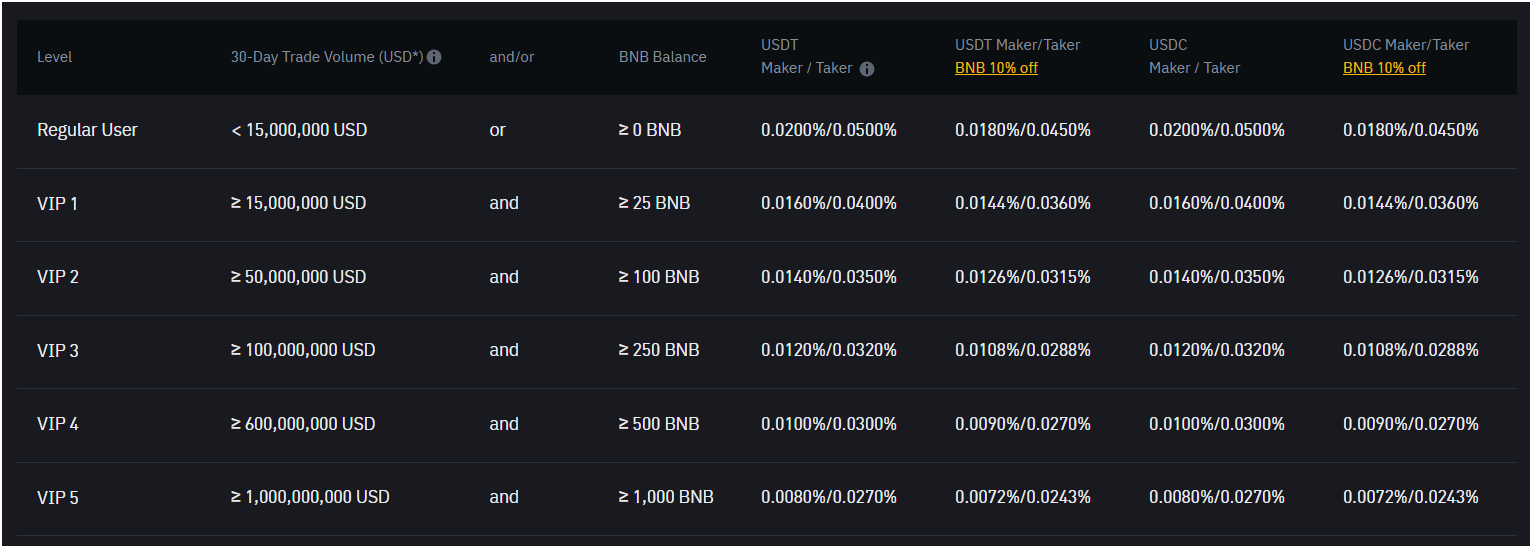
In options trading, Binance typically applies a flat fee per contract. Currently, the exchange charges a fee of 0.03% of the contract’s notional value, which is competitive compared to other crypto platforms.
Winner: Bybit and Binance have similar spot trading fees for regular users. However, Binance has lower futures taker fees (0.05% vs. 0.055%) compared to Bybit. But, Bybit has lower options trading fees (0.02% vs. 0.03%).
Deposit and Withdrawal Fees
For cryptocurrency deposits, Binance and Bybit typically don’t impose deposit fees. However, fees may be incurred from the network or blockchain itself.
For withdrawal fees, Binance generally offers better rates. The exact withdrawal fee depends on the cryptocurrency being withdrawn, and Binance tends to have lower withdrawal fees for popular coins like bitcoin and ethereum.
For example, Binance charges a 0.0001 btc fee for bitcoin withdrawals, while Bybit’s bitcoin withdrawal fee is 0.0005 btc, which is very high. Similarly, Binance’s withdrawal fees for ethereum are lower than Bybit’s. However, crypto withdrawal fees can be influenced by the blockchain’s network congestion.
Winner: Both exchanges have zero deposit fees. However, Binance has lower crypto withdrawal fees than Bybit.
Bybit vs Binance: Deposit and Withdrawal Methods
Bybit and Binance both provide a large range of deposit payment options to meet the needs of various user bases. Popular payment networks like Visa and Mastercard are among these choices, along with wire transfers, Google Pay, Apple Pay, and electronic fund transfers. There are also third-party providers like Banxa, Xanpool, MoonPay, and Mercuryo.
Also, Bybit supports over 300 payment methods on its P2P marketplace, whereas Binance claims to offer over 800 different local payment methods like UPI, PayPal, or even cash.
Bybit vs Binance: Trading Features and Tools
Leverage Trading
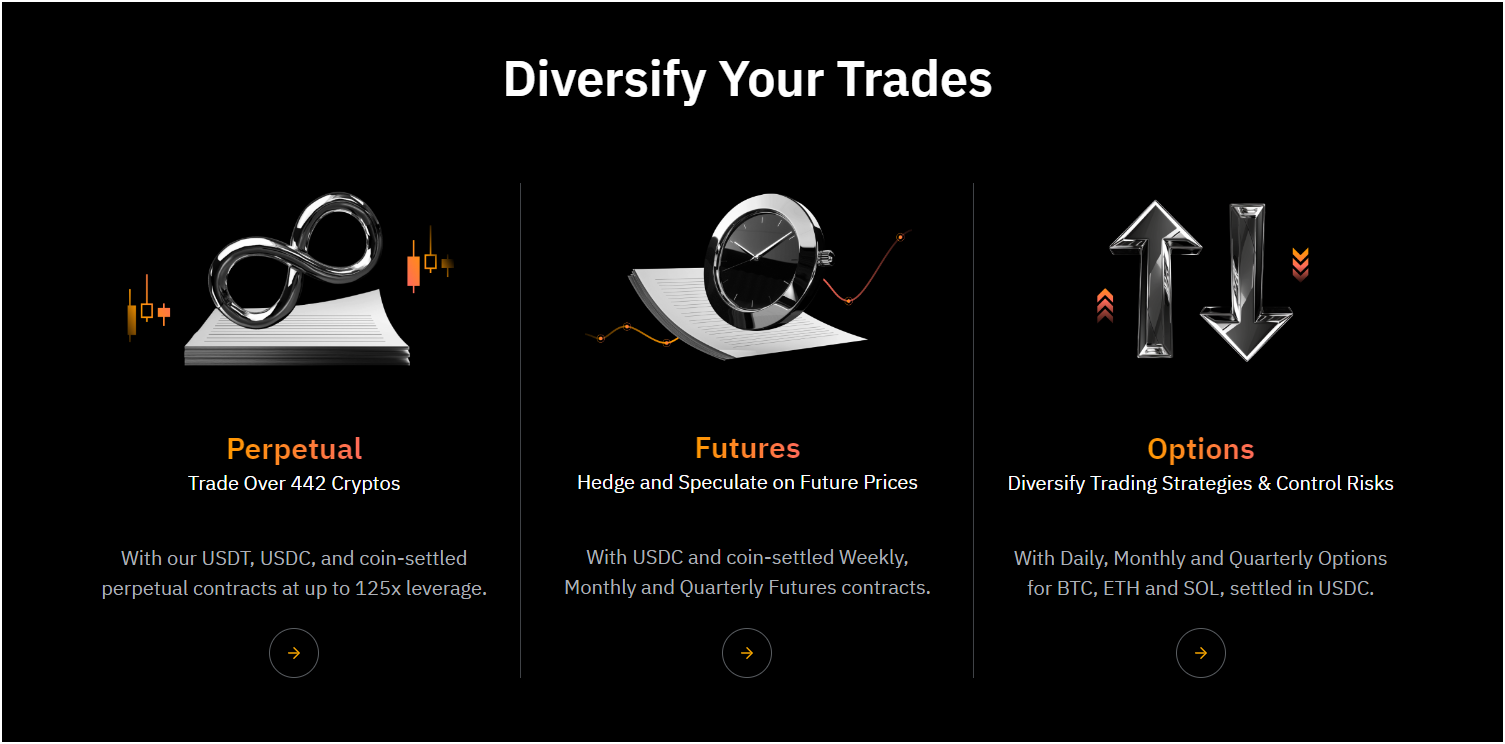
Bybit and Binance are popular leverage trading platforms. Both platforms provide futures trading, allowing traders to speculate on the future price of cryptocurrencies with borrowed funds.
Bybit offers leverage up to 100x for major cryptocurrencies and 75x for other altcoins. Binance, on the other hand, provides even higher leverage, with up to 125x for bitcoin (btc) and ethereum (eth), and 100x for lower market cap altcoins.
Both crypto exchanges offer three main types of perpetual contracts: USDT perpetuals, USDC perpetuals, and inverse perpetuals.
- USDT perpetuals: They use Tether (USDT) as the settlement currency. These contracts allow traders to go long or short on various cryptocurrencies while maintaining their positions in USDT. This type of contract is popular due to the stability of USDT and its widespread use in the crypto market.
- USDC perpetuals: Similar to USDT perpetuals, they use USD Coin (USDC) for settlement. These contracts provide an alternative stablecoin option for traders who prefer USDC over USDT. USDC perpetuals offer the same functionality as their USDT counterparts but with a different settlement currency.
- Inverse perpetuals: These contracts are settled in the base cryptocurrency of the pair being traded. For instance, if you are trading a btc perpetual contract, your profits or losses will be settled in btc. Inverse perpetuals are more appealing to traders who prefer to hold their assets in cryptocurrencies rather than stablecoins.
Bybit and Binance also offer margin trading options. In margin trading, you borrow funds to increase your potential profits. Both platforms provide two margin modes: cross-margin and isolated margin.
- Cross margin allows you to share the margin balance across all open positions. This means if one position starts to lose money, the system will automatically use the available balance from your other positions to prevent liquidation. While this can reduce the risk of liquidation, it also puts your entire portfolio at risk.
- Isolated margin, in contrast, isolates the margin for each individual position. If the position moves against you, only the margin allocated to that particular trade is at risk. The advantage here is that even if one position is liquidated, it won’t affect your other trades.
Both Bybit and Binance offer up to 5x leverage on margin trading for these modes. Apart from futures and margin trading, both Bybit and Binance provide access to options markets.
Winner: Binance offers high leverage compared to Bybit (125x vs. 100x in the futures market).
Advanced Order Types
Bybit and Binance both offer advanced order types beyond the standard market and limit orders. Here are the Bybit order types:
- Chase Limit Order: This order adjusts its limit price as the market price moves. It keeps your order close to the current price without needing constant updates. This way, you can follow price changes without manually changing your order.
- Conditional Order: A conditional order executes only when certain conditions are met, like reaching a specific price. It allows you to set up predefined triggers, so you don’t need to monitor the market constantly to enter or exit a trade.
- TWAP (Time-Weighted Average Price): TWAP divides a large order into smaller portions over time to minimize market impact. It helps you get an average price over a set period without causing sudden price changes in the market.
- Iceberg Order: An iceberg order hides most of your order while only a small portion is visible in the order book. It allows you to place large trades without showing the full size, reducing the chance of price shifts because of large orders.
- Scaled Order: This trading strategy allows you to divide your position among many price points. Doing this can diversify your risk and keep your order from being executed at one price point.
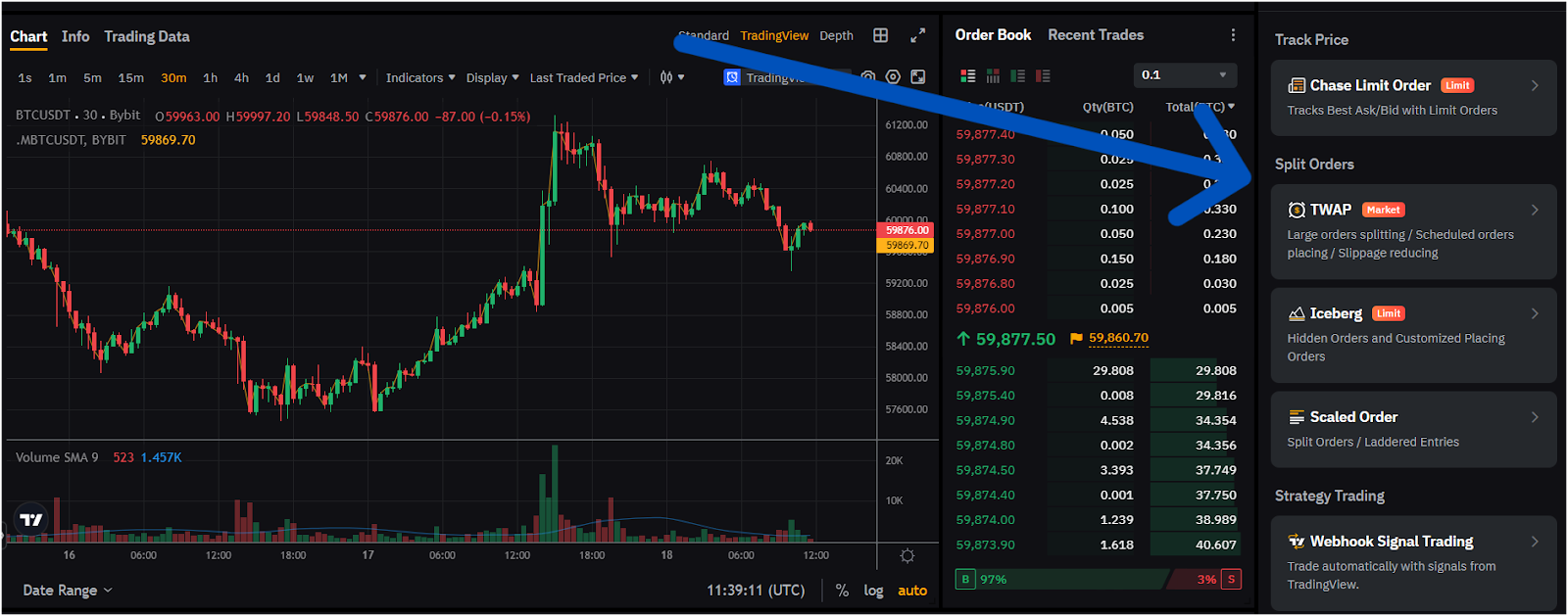
Binance also offers similar order types for leverage traders:
- TWAP (Time-Weighted Average Price)
- Scaled order
- Conditional order
- Trailing Stop: When the market advances in your favor, a trailing stop order automatically modifies your stop loss. This lets you hedge against unexpected declines while locking in earnings.
- Post Only: The post-only order ensures that your order is added to the market as a maker order, meaning it adds liquidity. If it would match an existing order, it won’t execute. This helps you avoid taker fees and ensures that your order doesn’t reduce market liquidity.

Trading Bots
Bybit trading bots are:
- Spot and Futures Grid Bot: Bybit’s grid bot regularly places buy and sell orders within a predetermined price range. It takes advantage of changes in the market by purchasing low and selling high. For example, if you set the bot to trade between $10,000 and $12,000, it will continue to place trades within that range, aiming to profit from price movements.
- DCA (Dollar-Cost Averaging) Bot: The DCA bot allows you to invest steadily over time by buying at regular intervals, which spreads your investment across different prices. This approach helps to minimize the risk of investing at a single high price. For instance, you could set the bot to purchase $100 worth of btc weekly.
- Futures Rebalancing Bot: This bot is designed to balance your futures portfolio by managing both long and short positions.

Binance trading bots are:
- Arbitrage Bot: Binance’s arbitrage bot looks for price differences across various markets to generate profit. It buys in one market where prices are lower and sells in another where prices are higher, capturing small but consistent gains.
- Rebalancing Bot: The rebalancing bot on Binance automatically adjusts your asset allocation to maintain a target ratio. If one asset’s price rises and shifts your portfolio balance, the bot will sell a portion of that asset and redistribute it to maintain the desired allocation.
- Auto-Invest Bot: It enables you to build a long-term investment strategy by making scheduled purchases. It’s a hands-off approach similar to DCA, where the bot buys crypto on a regular schedule.
- Futures TWAP Bot: The bot helps you break large trades into smaller ones over time to get an average price. This prevents a large trade from significantly impacting the market and allows you to get a fair execution price on your orders.
- Futures VP (Volume Participation) Bot: The VP bot executes your trades in proportion to the trading volume in the market. It adjusts your order size based on market activity, helping to align your trades with current liquidity and ensuring that your orders don’t overwhelm the market. This is available on API trading only.
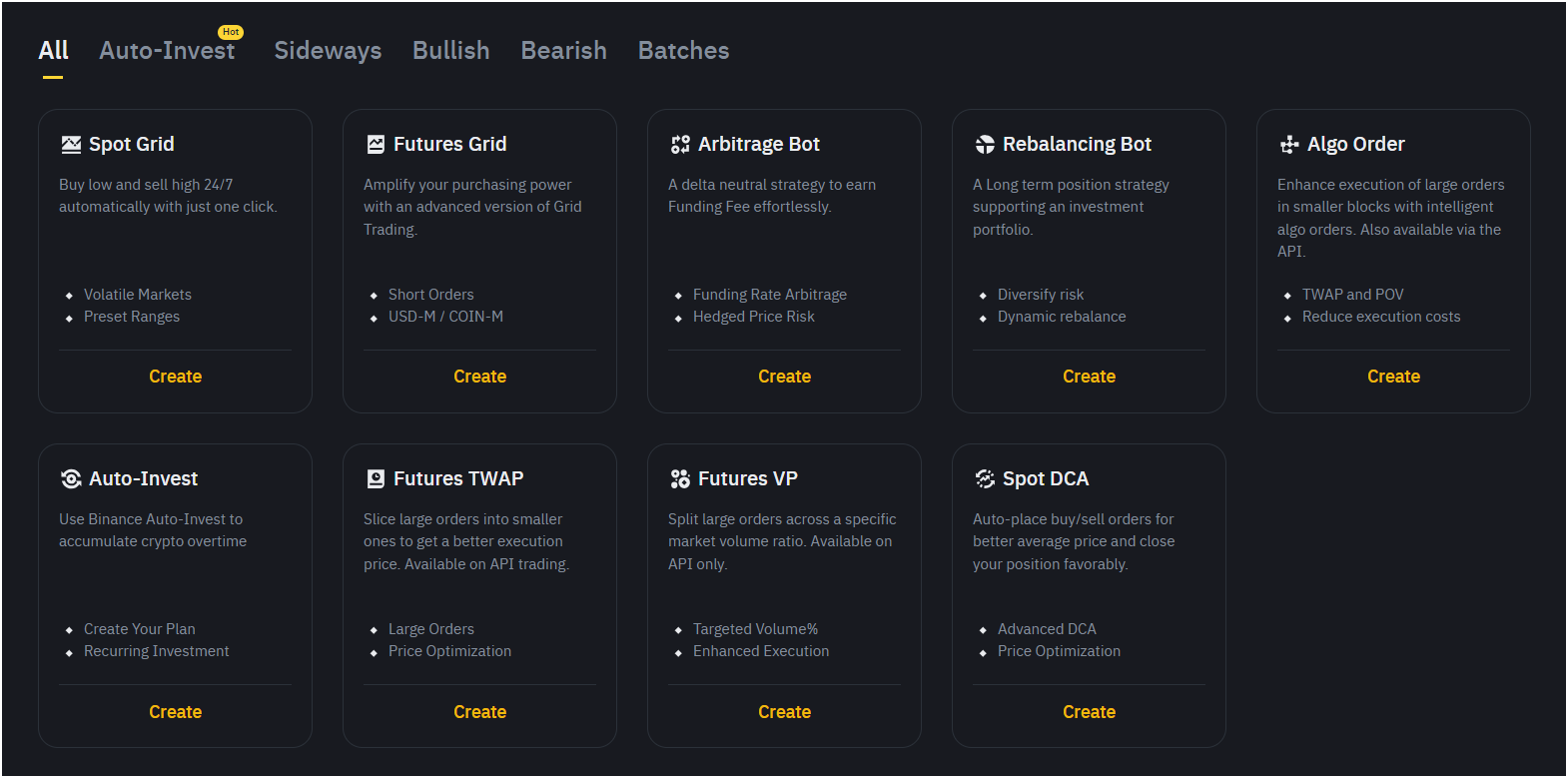
Winner: Binance offers more trading bots than Bybit, including Arbitrage, TWAP, and Auto-Invest features.
Copy Trading
The ability to replicate the trading tactics of seasoned traders through copy trading is best for beginners. In 2021, Bybit introduced its copy trading service, which lets you mimic the trades done by more knowledgeable traders.
Based on their past performance, you can choose traders, and once you do, your account will automatically execute each transaction they make. Bybit has a 10% profit share fee for successful trades, and you can opt out of a trader’s strategy whenever necessary.
On the other hand, Binance has recently started offering copy trading features. It is not as popular and vast as Bybit. However, through third-party API integrations or strategies, you can automate trading strategies on Binance. Binance instead focuses more on trading bots and automated tools.
Leveraged Tokens
Leveraged tokens are an innovative way to trade with leverage without the risk of liquidation. Bybit and Binance offer leveraged tokens, which are simplified tools to gain leveraged exposure to crypto without managing collateral or risking liquidation.
These tokens typically offer 2x or 3x leverage, meaning that you can amplify your profits (or losses) by two or three times. For instance, you could buy a 3x btc token, which increases exposure to bitcoin’s price by threefold.
With over 20 leveraged tokens available on both exchanges, including BTCUP, BTCDOWN, and ETHUP, you can easily gain leveraged exposure to the most popular cryptocurrencies. These tokens also allow you to enjoy the benefits of leverage without worrying about margin calls.
Staking and Earn Services
In terms of earning opportunities through staking, Binance has an extensive offering, supporting more than 100 staking assets, including ethereum 2.0, Solana, and more.
Binance’s “Simple Earn” feature offers flexible and locked staking options, allowing you to earn interest on your crypto assets. Flexible staking offers lower yields but higher liquidity, while locked staking can provide yields of up to 20% or more, depending on the asset and duration. For example, staking Polkadot (DOT) on Binance can yield up to 14.79% annually.
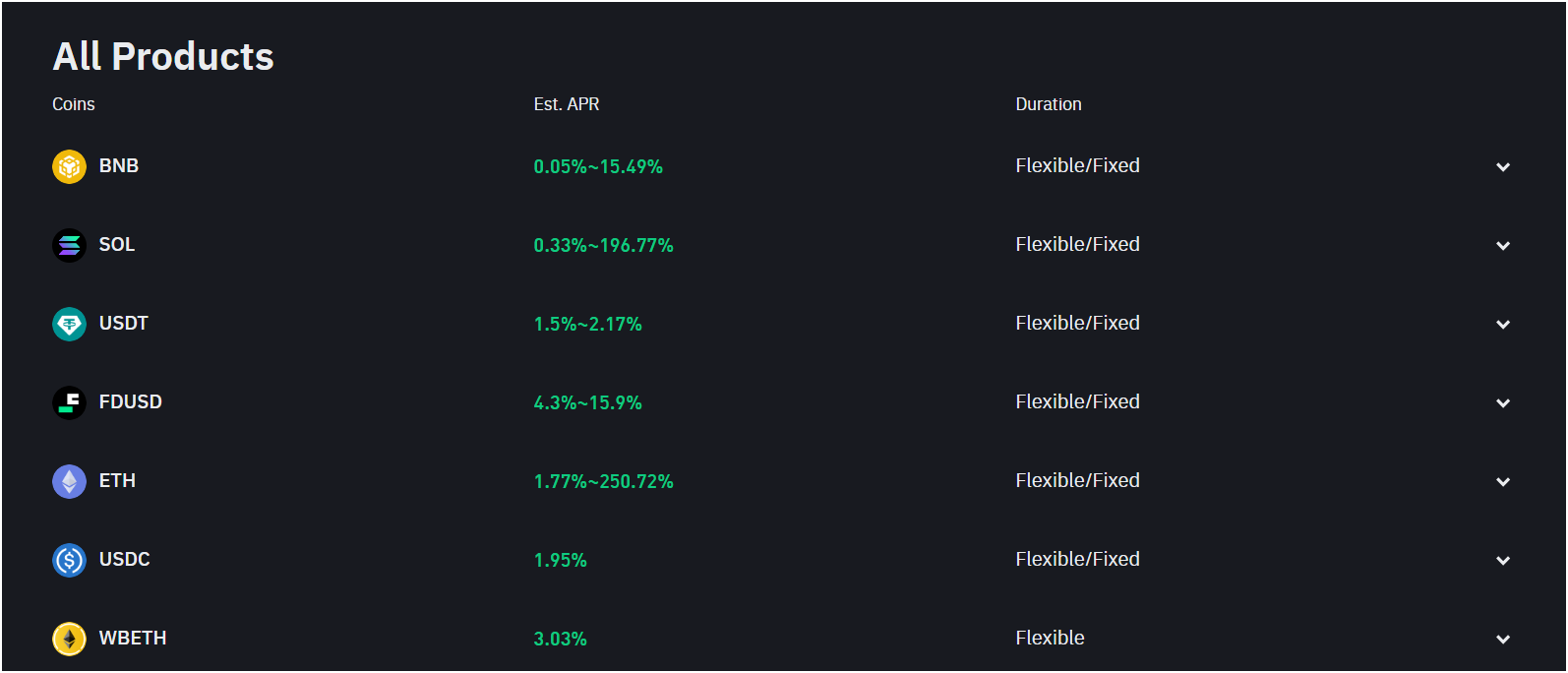
Bybit is also the best crypto staking platform, but in a more limited fashion compared to Binance. You can stake major cryptocurrencies such as bitcoin and ethereum and many newly listed coins and tokens.
Bybit’s Earn products include flexible savings, DeFi staking, and dual investment, though their range of supported assets is not as extensive as Binance. Despite this, Bybit frequently offers promotional rates on popular coins, giving you a chance to earn competitive interest on your holdings.
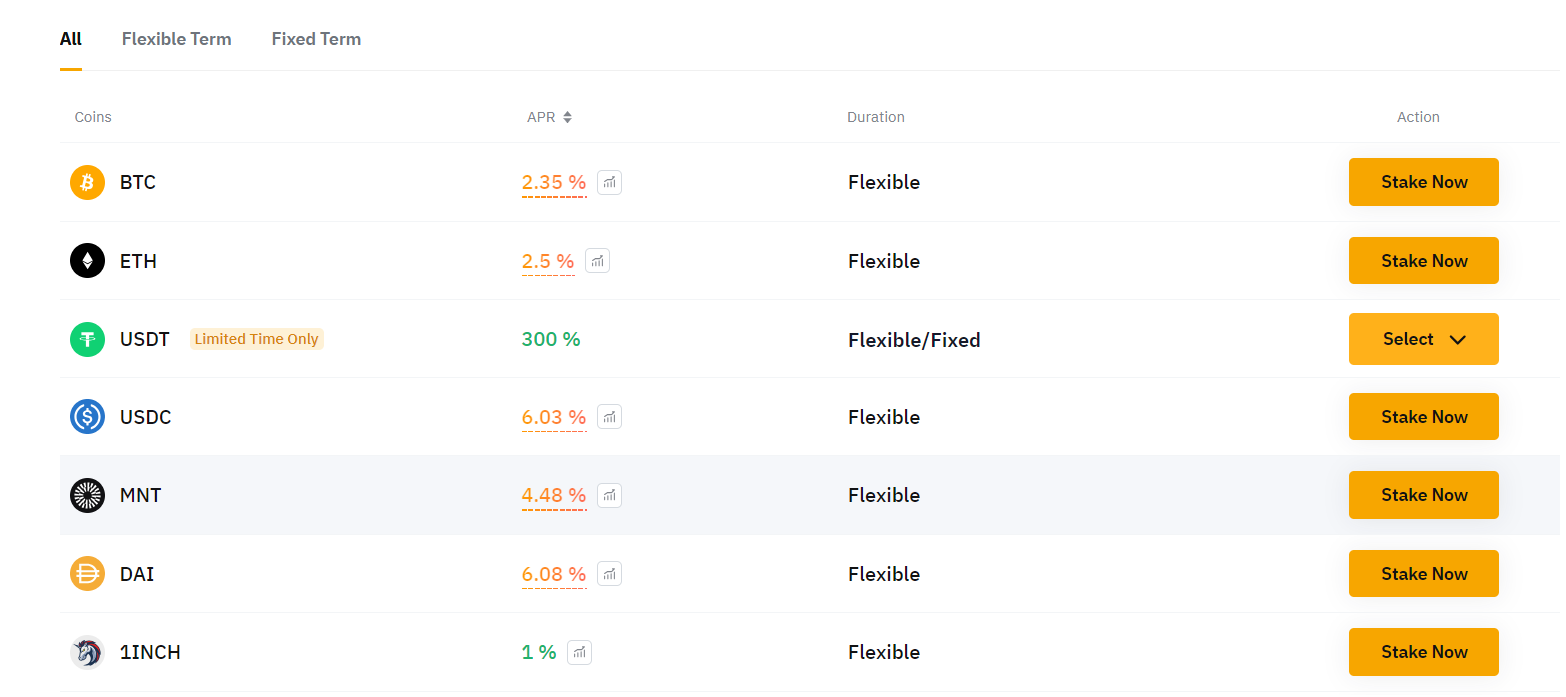
nft Marketplace
nft markets are provided by both exchanges, but Binance’s well-established infrastructure gives it the edge. The nft/home” data-wpel-link=”external” target=”_blank” rel=”nofollow external noopener noreferrer”>Binance nft Marketplace was introduced in 2021 and facilitates the purchase, sale, and creation of nfts. Digital art, virtual real estate, and in-game items are just a few of the many nfts that it supports.
Binance has become a major participant in the nft market by hosting unique collections from well-known artists. Its smooth interaction with ethereum and the BNB Smart Chain facilitates the transfer of assets between different ecosystems.
nft/” data-wpel-link=”external” target=”_blank” rel=”nofollow external noopener noreferrer”>Bybit nfts, on the other hand, entered the marketplace slightly later. While smaller, Bybit’s nft platform offers a curated selection of nfts, focusing mainly on exclusive and limited-edition collections.
Bybit’s integration is user-friendly, and like Binance, it supports the purchase and sale of nfts through crypto wallets connected to the platform. However, the range of available assets is narrower than Binance’s.
Launchpad
The Launchpad feature on both exchanges allows you to participate in new token offerings before they are widely available. Binance’s Launchpad is renowned for its large number of successful token sales, including major projects like Axie Infinity (AXS) and Polygon (MATIC). Binance users can stake Binance Coin (BNB) to receive tokens.
Bybit’s Launchpad also offers access to new and emerging projects but on a smaller scale. Bybit allows you to stake assets like BIT or USDT to qualify for new token offerings.
Bybit has introduced several successful projects, such as ApeX Protocol (APEX) and others, although its range is not as broad as Binance. However, Bybit’s Launchpad is well-regarded for its transparency and simplicity, making it accessible even for beginners.
Bybit vs Binance: Supported Cryptocurrencies
Binance, with its support for around 400 coins, primarily focuses on well-established tokens that have a high market capitalization. This makes it a suitable choice for those who prefer trading or investing in well-known, widely recognized cryptocurrencies. It supports trading pairs like btc/USDT, btc/USDC, and btc/eth.
On the other hand, Bybit supports an impressive selection of about 1,200 coins, including many new and emerging tokens. This platform provides coverage across various popular niches such as DeFi tokens, nft tokens, smart contracts, metaverse, and GameFi. For users interested in exploring a broader range of cryptocurrencies and newer altcoins, Bybit offers a more diverse and expansive selection.
So, if your interest lies in trading major, high-market-cap tokens, Binance is the better option. However, if you are looking for a platform with a wide array of new and niche tokens across different sectors, Bybit stands out as the preferable choice.
Winner: Bybit supports more cryptocurrencies than Binance (1200 vs. 400 coins and tokens).
Bybit vs Binance: Security and Regulatory Compliance
Both Bybit and Binance prioritize security and put in place several safeguards to keep customers safe. To protect customer money, both exchanges use cold wallet storage and two-factor authentication (2FA). Additionally, both systems examine Proof of Reserves to make sure that client assets are backed 1:1.
Some popular security measures are:
- 2FA
- Withdrawal address whitelisting
- Anti-phishing code
- Maximum withdrawal amount restrictions
- Passkeys
- Fund password
Binance further enhances security with its SAFU (Secure Asset Fund for Users), a $1 billion insurance fund that compensates users in case of losses due to security breaches. Bybit, while also highly secure, lacks a similar fund.
Additionally, Binance was once bitcoin-hack-over-40-million-of-cryptocurrency-stolen.html” data-wpel-link=”external” target=”_blank” rel=”nofollow external noopener noreferrer”>hacked in 2019 but compensated users fully. Bybit, on the other hand, has not faced any significant breaches to date.
Bybit Licenses
Here are the two Bybit regulatory licenses. It is generally operating without any license in many countries.
- Granted an in-principal license as a Virtual Asset Service Provider in Dubai.
- Regulated by the authorities in Cyprus
Binance Licenses
Binance is highly regulated compared to Bybit and it holds multiple licenses:
- Digital Asset Service Provider (DASP) by the Autorité des Marchés Financiers (AMF) in France
- Virtual Asset Service Provider (VASP) registration by Legal Entities of the Republic of Lithuania
- VASP by the Bank of Spain
- A Category 4 license as a crypto-Asset Service Provider (CASP) by the Central Bank of Bahrain
- Digital Currency Exchange (DCE) provider registration by the Australian Transaction Reports and Analysis Centre (AUSTRAC)
Check the full list of Binance licenses here.
Winner: Both exchanges have high security with multiple safety measures, but Binance is more regulated and licensed in multiple jurisdictions compared to Bybit.
Bybit vs Binance: User Experience and Interface
Both Bybit and Binance offer feature-rich platforms, though the vast array of options can overwhelm beginners. The interfaces of both platforms are quite similar, with intuitive navigation menus for sections like trading, buying crypto, derivatives, and earning.
While both platforms are not the easiest for beginners, users report that Bybit’s interface is slightly more streamlined, particularly for derivatives trading. However, Binance’s greater range of products, such as staking, nfts, and advanced trading options, may appeal more to experienced users.
In terms of execution speed, Bybit’s API integration is often praised for its quick data updates, which may benefit high-frequency traders.
Winner: Both crypto trading platforms provide a comparable user experience, but Binance’s broader feature set may be slightly harder to navigate for newcomers.
Bybit and Binance: Mobile App Comparison
Both Bybit and Binance provide robust mobile apps on iOS and Android, enabling users to trade, purchase cryptocurrencies, and monitor their portfolios conveniently.
Binance’s app is particularly popular, earning high ratings on both Google Play (4.6 stars) and the bitcoin–crypto/id1436799971″ data-wpel-link=”external” target=”_blank” rel=”nofollow external noopener noreferrer”>Apple App Store (4.6 stars). The app mirrors most features available on the web platform, such as staking and nft transactions.
Similarly, Bybit’s app is also available on Android and crypto/id1488296980″ data-wpel-link=”external” target=”_blank” rel=”nofollow external noopener noreferrer”>iOS devices. It is intuitive and efficient, especially favored by traders in derivatives markets, as it offers real-time updates and essential trading tools.
While Bybit’s app is well-suited for trading-focused users, Binance’s broader range of services, including savings and lending options, may attract those seeking additional financial products.
Bybit vs Binance: Customer Support and Service
When it comes to customer support, both platforms provide various channels such as live chat, email, and help centers with extensive FAQs. Binance offers 24/7 live support in multiple languages, which gives it an edge in terms of availability and global reach. However, user feedback suggests that Binance’s support can sometimes be slow due to the high volume of users.
Bybit, despite having a smaller user base, is known for quick and responsive customer service, especially through its live chat feature. Both exchanges also maintain active communities on platforms like Telegram and twitter, which serve as additional support channels.
Conclusion: Which is Better?
To summarize our comparison of Bybit vs Binance, both are top performers in the cryptocurrency exchange sector. Bybit is suited for experienced traders who specialize in derivatives trading.
Binance, on the other hand, provides a broader range of services, including nfts, staking products, Binance Pay, and a launchpad for new projects. It is better suited for those who seek access to a wider range of financial products.
If you want a broader selection of services and high-volume crypto trading without price slippage, Binance is the superior option. For individuals who specialize in derivatives, Bybit may be a better option.
FAQs
Is Bybit Better Than Binance?
Bybit is ideal for traders who focus on derivatives trading and leverage. It offers advanced tools and a simple interface, which makes it appealing to more experienced traders. Bybit also supports over 1200 digital assets including any new projects, which is better for portfolio diversification. It is also better in terms of a copy trading portal.
Binance, however, provides a much broader range of services and offers high trading volume and liquidity. If you are looking for an all-in-one platform with many options, Binance could be better for you. But if you are primarily a derivatives trader, Bybit might suit your needs more. Both platforms are good, but one may fit your trading style better than the other.
Which Exchange is Safer to Use, Binance or Bybit?
Binance has a more extensive security infrastructure, as it is a larger platform with more services. It uses two-factor authentication (2FA), and anti-phishing codes, and offers a Secure Asset Fund for Users (SAFU) to cover losses in case of a hack.
Bybit also offers 2FA and has implemented cold storage for most of its users’ funds. While both platforms have solid security records, Binance has experienced security breaches in the past but compensated its users. Bybit has not faced any significant breaches to date.
Both exchanges are generally safe, but Binance’s larger user base might make it more prone to attacks, while Bybit offers a more focused but smaller-scale security approach.
What are the Differences and Similarities Between Bybit and Binance?
Bybit and Binance differ in several ways, starting with their focus. Bybit is mainly a derivatives platform, while Binance offers better services in spot trading, staking, and savings products. About supported cryptocurrencies, Binance supports over 1200 crypto tokens, whereas Binance offers only 400 popular crypto assets.
Binance offers more financial services beyond just trading, like Binance Pay, a high-volume OTC market for institutional traders, and decentralized finance (DeFi) products.
In terms of similarities, both platforms support futures trading, offer leverage, and have strong security features. They also provide access to mobile apps and advanced trading tools like charting software.
How Do the Fees Compare Between Bybit and Binance?
Bybit charges a flat 0.1% for spot trading and 0.02% making and 0.055% taker for futures trading with discounts available for high-volume traders.
Binance also offers low fees, starting at 0.1% for spot trading and 0.02%/0.05% for futures, which can go lower if you hold Binance Coin (BNB) or use it to pay for fees. Binance offers tiered discounts based on trading volume, making it cheaper for high-volume traders.
Which Exchange Has Better Liquidity and Trading Volume?
According to CoinMarketCap data, Binance has far better liquidity and trade volume than Bybit. Binance is one of the world’s largest exchanges, with over $50 billion in trading activity. This means that users have a better chance of finding buyers and sellers at any time.
Bybit, while still providing good liquidity, particularly in its derivatives market, cannot compete with Binance’s large trading volume. Its trade volume is from $10 to $15 billion each day. For individuals who trade in large sums or regularly, Binance’s strong liquidity is a significant benefit.
Which Exchange is Better for Spot Trading?
When it comes to spot trading, Binance is the clear winner. It offers high trading volume, popular coins, and has deep liquidity pools, which make it easy to trade without significant price slippage. Binance also provides multiple trading pairs, advanced charting tools, and a user-friendly interface for both beginners and experienced traders.






